Even though the MESSENGER spacecraft experienced a “hiccup” during its third and final flyby of Mercury on Sept. 29, scientists are still pleased and surprised by the data garnered. The spacecraft went into safe mode, shutting down temporarily because of a power system switchover during a solar eclipse as it approached the planet and only half of the expected observations were carried out. But the new data – combined with observations from the two previous flybys — provide an almost complete view of Mercury’s surface and offer new, unexpected scientific findings. “Although the area viewed for the first time by spacecraft was less than 350 miles across at the equator, the new images reminded us that Mercury continues to hold surprises,” said principal investigator Sean Solomon.
The most important aspect of the flyby was a critical gravity assist to remain on course to enter into orbit around Mercury in 2011. Additionally, the spacecraft’s cameras and instruments collected high-resolution and color images unveiling another 6 percent of the planet’s surface never before seen at close range.
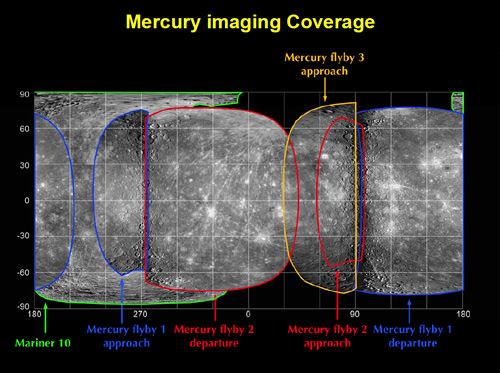
Solomon said at today’s press conference that all the data gathered on Mercury so far are like first few chapters of a novel; we’ve learned much, but much more of the story remains. Approximately 98 percent of Mercury’s surface now has been imaged by NASA spacecraft. After MESSENGER goes into orbit around Mercury, it will see the polar regions, which are the only unobserved areas of the planet.
Many new features were revealed during the third flyby, including a region with a bright area surrounding an irregular depression, suspected to be volcanic in origin. Other images revealed a double-ring impact basin approximately 180 miles across. The basin is similar to a feature scientists call the Raditladi basin, which was viewed during the probe’s first flyby of Mercury in January 2008.
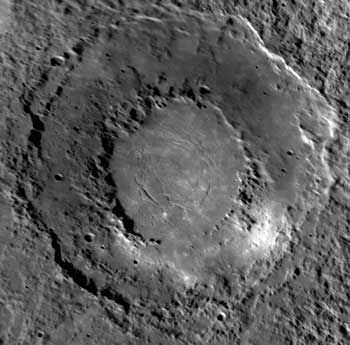
“This double-ring basin, seen in detail for the first time, is remarkably well preserved,” said Brett Denevi, a member of the probe’s imaging team and a postdoctoral researcher at Arizona State University in Tempe. “One similarity to Raditladi is its age, which has been estimated to be approximately one billion years old. Such an age is quite young for an impact basin, because most basins are about four times older. The inner floor of this basin is even younger than the basin itself and differs in color from its surroundings. We may have found the youngest volcanic material on Mercury.”
One of the spacecraft’s instruments conducted its most extensive observations to date of Mercury’s exosphere, or thin atmosphere, during this encounter. The flyby allowed for the first detailed scans over Mercury’s north and south poles. The probe also has begun to reveal how Mercury’s atmosphere varies with its distance from the sun.
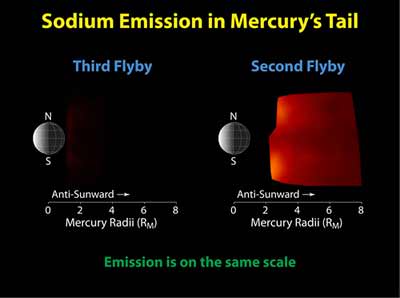
“A striking illustration of what we call ‘seasonal’ effects in Mercury’s exosphere is that the neutral sodium tail, so prominent in the first two flybys, is 10 to 20 times less intense in emission and significantly reduced in extent,” says participating scientist Ron Vervack, of the Johns Hopkins University Applied Physics Laboratory, or APL, in Laurel, Md. “This difference is related to expected variations in solar radiation pressure as Mercury moves in its orbit and demonstrates why Mercury’s exosphere is one of the most dynamic in the solar system.”
The observations also show that calcium and magnesium exhibit different seasonal changes than sodium. Studying the seasonal changes in all exospheric constituents during the mission orbital phase will provide key information on the relative importance of the processes that generate, sustain, and modify Mercury’s atmosphere.
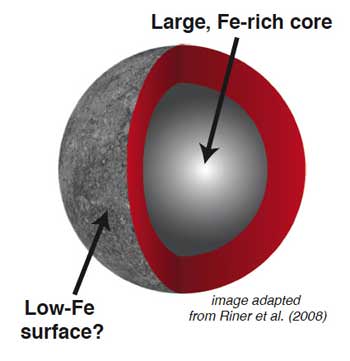
The third flyby also revealed new information on the abundances of iron and titanium in Mercury’s surface materials. Earlier Earth and spacecraft-based observations showed that Mercury’s surface has a very low concentration of iron in silicate minerals, a result that led to the view that the planet’s crust is generally low in iron.
“Now we know Mercury’s surface has an average iron and titanium abundance that is higher than most of us expected, similar to some lunar mare basalts,” says David Lawrence, an APL participating mission scientist.
The spacecraft has completed nearly three-quarters of its 4.9-billion-mile journey to enter orbit around Mercury. The full trip will include more than 15 trips around the sun. In addition to flying by Mercury, the spacecraft flew past Earth in August 2005 and Venus in October 2006 and June 2007.
Source: NASA

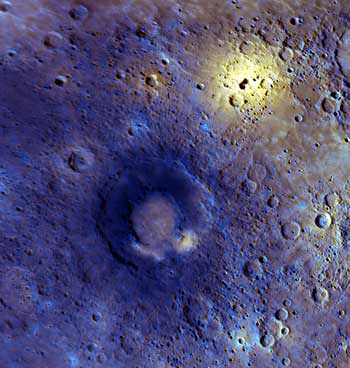
All these crater images look like mounds if your room light is coming from the wrong direction. To fix this, copy the image to your desk top and rotate it. On my Mac, Preview does this in 90 degree increments. Presumably, a PC does the same thing.
i’dd really love to know how being so close to the sun influences the pols of mercury , so , can’t wait to see messenger in orbit :p
I wonder a bit how it is that the spacecraft is able to determine the chemical (iron vs silicate) composition of the planet.
LC
Can anyone say why the spacecraft needs flybys if it is eventually going to Mercury. Why the spacecraft can’t be captured during these flybys.
The orbital energy of the craft, kinetic plus potential
E = p^2/2m – GMm/r, (p = momentum M mass of Mercury, m spacecraft mass, G Newtonian gravitational constant )
is too large. The point of the flybys is to trasfer total energy from the craft to Mercury. This is the same planetary billiard ball maneuver as has been done to get beyond Jupiter. Otherwise it would require a lot of rocket fuel to do this.
It sounds odd to think that it requires a large energy budget to get to Mercury. Yet if you think about it since the Earth orbits the sun at 29.5 km/sec to get a craft to the sun you need to fire a rocket so it has zero velocity in the heliocentric coordinates. Getting to Mercury is not quite that bad, but the energy costs are high. So using flybys of Venus and Mercury are ways of saving on the energy budget
LC
Thanks Lawrence
At one time it was believed that water ice might be the source of high reflectance values seen at the poles. Or possibly even molten metals of some sort?
Then, our Moon was seen to have water molecules BEING CREATED by the sputtering of ionized solar wind off Luna’s surface.
Does this also happen on Mercury? The article states that sodium, calcium and magnesium have been detected… no mention of oxygen in the sample though?
I found this elsewhere on the net: “Only Mercury’s polar regions remain unexplored, and images of those regions will be collected when MESSENGER is in orbit.”